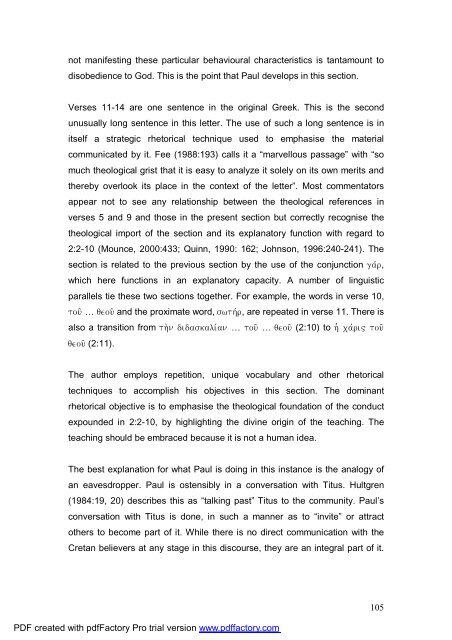A Text centred rhetorical analysis of Paul's Letter to Titus
A Text centred rhetorical analysis of Paul's Letter to Titus
A Text centred rhetorical analysis of Paul's Letter to Titus
You also want an ePaper? Increase the reach of your titles
YUMPU automatically turns print PDFs into web optimized ePapers that Google loves.
not manifesting these particular behavioural characteristics is tantamount <strong>to</strong><br />
disobedience <strong>to</strong> God. This is the point that Paul develops in this section.<br />
Verses 11-14 are one sentence in the original Greek. This is the second<br />
unusually long sentence in this letter. The use <strong>of</strong> such a long sentence is in<br />
itself a strategic <strong>rhe<strong>to</strong>rical</strong> technique used <strong>to</strong> emphasise the material<br />
communicated by it. Fee (1988:193) calls it a “marvellous passage” with “so<br />
much theological grist that it is easy <strong>to</strong> analyze it solely on its own merits and<br />
thereby overlook its place in the context <strong>of</strong> the letter”. Most commenta<strong>to</strong>rs<br />
appear not <strong>to</strong> see any relationship between the theological references in<br />
verses 5 and 9 and those in the present section but correctly recognise the<br />
theological import <strong>of</strong> the section and its explana<strong>to</strong>ry function with regard <strong>to</strong><br />
2:2-10 (Mounce, 2000:433; Quinn, 1990: 162; Johnson, 1996:240-241). The<br />
section is related <strong>to</strong> the previous section by the use <strong>of</strong> the conjunction gavr,<br />
which here functions in an explana<strong>to</strong>ry capacity. A number <strong>of</strong> linguistic<br />
parallels tie these two sections <strong>to</strong>gether. For example, the words in verse 10,<br />
<strong>to</strong>u` … qeou` and the proximate word, swthvr, are repeated in verse 11. There is<br />
also a transition from th;n didaskalivan … <strong>to</strong>u` … qeou` (2:10) <strong>to</strong> hJ cavri" <strong>to</strong>u`<br />
qeou' (2:11).<br />
The author employs repetition, unique vocabulary and other <strong>rhe<strong>to</strong>rical</strong><br />
techniques <strong>to</strong> accomplish his objectives in this section. The dominant<br />
<strong>rhe<strong>to</strong>rical</strong> objective is <strong>to</strong> emphasise the theological foundation <strong>of</strong> the conduct<br />
expounded in 2:2-10, by highlighting the divine origin <strong>of</strong> the teaching. The<br />
teaching should be embraced because it is not a human idea.<br />
The best explanation for what Paul is doing in this instance is the analogy <strong>of</strong><br />
an eavesdropper. Paul is ostensibly in a conversation with <strong>Titus</strong>. Hultgren<br />
(1984:19, 20) describes this as “talking past” <strong>Titus</strong> <strong>to</strong> the community. Paul’s<br />
conversation with <strong>Titus</strong> is done, in such a manner as <strong>to</strong> “invite” or attract<br />
others <strong>to</strong> become part <strong>of</strong> it. While there is no direct communication with the<br />
Cretan believers at any stage in this discourse, they are an integral part <strong>of</strong> it.<br />
PDF created with pdfFac<strong>to</strong>ry Pro trial version www.pdffac<strong>to</strong>ry.com<br />
105

















